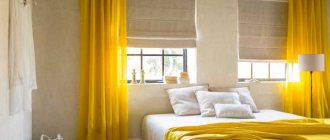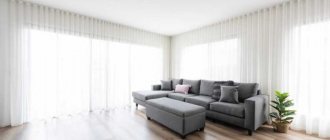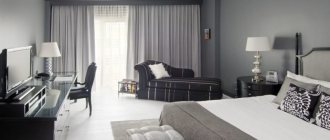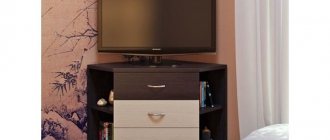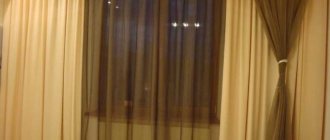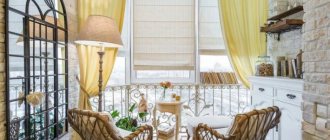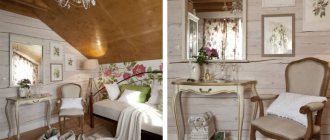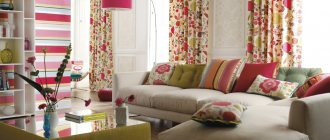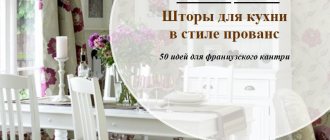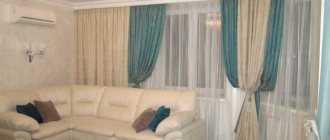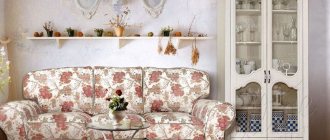Purpose of grabs
Tiebacks in curtain design perform an important decorative function. It is the tiebacks that often become the “highlight” when decorating a window opening: with simple curtains, interesting, bright, original tiebacks look harmonious and appropriate.
In addition, tiebacks perform an important practical function: they beautifully fix the curtains in the open position, allowing sunlight to penetrate into the room.
Using Magnetic Holders
Magnetic holders come in a variety of colors, sizes, and shapes. They can be made of different materials: metal, plastic, glass. Magnetic holders are very convenient and easy to use.
The downside is that they can only be used to secure curtains made of light fabrics in a certain position. Magnetic clips can be used to grab the curtain in several places and fix the tulle at different levels.
Types of curtain tiebacks
Curtain ties are an interior element, the variety of which simply knows no bounds. Pickups can be:
- fabric;
- magnetic made of glass, wood, metal;
- from a wide variety of materials - leather, brushes, cords, satin ribbons, jewelry...;
- obsolete items - belts, gloves, cutlery, children's toys.
You can easily find a lot of interesting photos of curtain tiebacks on the Internet. Brave designers are ready to use literally everything that is at hand for this small decorative element.
How to make a “corner” garter
To create a “corner” garter, lift the curtain by the inner corner to the desired height and align the corner with the main curtain fabric in this place, attaching one magnet to the end of the corner, and attaching the second magnet to the other side. Both magnets will attract each other and will hold the corner of the curtain in a raised position. You can safely purchase magnetic tie-backs for this method of tying any fabrics and even heavy ones. And most importantly, curtain magnets do not damage the fabric at all. This is a huge advantage of this accessory.
Here is another method, but it is more suitable for light flowing fabrics, but in some cases it can also be used for medium-density fabrics. It is necessary to assemble the curtain from the side with your hands, make the folds sequentially, slowly, wrap it with a cable or magnetic tape and fix it, connecting the two parts of the magnet. In order for our drapery to look beautiful, it is necessary to pull out the outer folds of the fabric from under the cable or tape.
That is, we make overlaps and, depending on the planned model, you can do this at the level or below the window sill, or closer to the ceiling.
There is another way. It looks very unusual and is especially appropriate when you have a curtain made of lace tulle, light organza, tulle or veil. This method of decorating curtains looks fresh and adds fluffiness to the curtains.
For such gathering of light fabric, it is better to choose small curtain magnets, on a short cable or on a short satin ribbon. And here you can choose magnets either to match the color of the canvas, or in contrast, with decorative additions, for example, artificial flowers - it all depends on your preferences, interior style and curtain model.
Making grabs
The size of the tie depends on the type of fabric from which the curtain is made. For light curtains made of organza, chiffon, polyester, tiebacks with a width of about 20-25 cm will be sufficient. Thicker curtains made of velvet, brocade, blackout require wider tiebacks - 30-40 cm.
In order for the tiebacks to be neat and symmetrical, a pattern is prepared from thick paper or cardboard. Then the pattern is transferred to the fabric and the parts are sewn together. The tiebacks must be carefully ironed or steamed. It is better to add extra stitching for thick fabrics.
At what height should I hang it?
Curtain tiebacks can be attached to the wall at different distances from the window opening. This largely determines what the size of the window will visually appear to be. Hanged close to the opening, they will narrow it; installed at a distance, they will widen it.
When choosing a location for installing tiebacks for curtains and tulle, you need to consider the following:
- Canvases assembled at the level of the window sill, as when attached to one side, do not create a visual illusion. This method is preferable when the curtains occupy the entire wall.
- Drapery above the level of the window sill, at a distance of approximately 2/3 from the floor, visually expands the window opening. This technique is especially good in the kitchen, where it is customary to hang short curtains.
- Holders installed 25-35 cm below the level of the window sill visually make the opening narrower and higher. This method is especially relevant when the windows are decorated with heavy curtains that reach the floor or extend along the floor.
The height of the hooks depends on the effect you want to achieve: to make the ceilings higher or to expand the room, so before attaching the hooks, mentally imagine the end result.
Tieback color
The color scheme of the tiebacks, like them themselves, can be very different. The tiebacks can be made to match the color of the curtain, then they will serve only a functional purpose - to hold the curtain.
Contrasting tiebacks are made from partner curtain fabric, or any other fabric that matches the color. In the kitchen, the scoop can be made in the same color as the tablecloth and potholders, or other bright kitchen utensils. For a child's room, interior elements in pink, soft lilac, if this is a girl's room, tones are suitable.
Tiebacks using gold thread, with fringe and tassels are very formal and would be more suitable for decorating a living room in the appropriate style.
What are they?
The variety of types of curtain tiebacks, from the simplest fabric ones to complex rigid shaped products, is amazing. To choose the appropriate option, you need to mentally imagine what the model you like will look like in a specific place.
Conventionally, they can be divided into three groups:
- Rigid holders manufactured in mass production.
- Fabric products included with curtains.
- Unique accessories, made to order or independently.
Let's look at the most popular models and find out in which cases they are most appropriate.
Static metal
Original holders for curtains and in the form of door handles - structures fixed to the wall, into which the fabric is tucked. They can be of a simple form, in the form of a thick steel rod bent like a long hook, or they can be exquisite works of design art.
From curtain fabric
Fabric holders are purchased complete with ready-made curtains or ordered when sewing them. The standard double-sided “banana” model has a plastic lining inside, thanks to which it holds its shape and beautifully “hugs” the curtain. Blocks are punched at the ends of the “banana” or loops are sewn on, by which it is hung on a hook for mounting on the wall.
Hairpins
Cloth clips made of metal, plastic or wood differ from similar hair accessories only in size. They must match the fabric in density. Light tulle curtains are best suited with small, elegant pins; curtains made of thick fabrics will need to choose large items. Hairpins are not suitable for heavy curtains; metal holders or fabric “banana” tiebacks are more appropriate here.
Kanzashi
By design, tiebacks for kanzashi curtains can be pins, bananas, or strips of fabric. They are distinguished from other models by their satin decor, made using the Japanese Hana kanzashi technique. Such DIY decorations are the perfect way to beautifully drape fabric. Many handmade craftsmen specialize in their production.
Hana kanzashi - hairpins with silk flowers. They are created from squares of silk using the folding technique. Each square, rolled with tongs, turns into a flower petal. Petals are attached to a base to create whole flowers, or a sequence of flowers.
From foamiran
Like kanzashi, foamiran curtain tiebacks differ from other models not in design, but in special decorations. Magnificent flowers bloom magnificently on them, made by the hands of experienced craftswomen, almost indistinguishable from real ones.
Foamiran is a decorative foam material used in various types of needlework. It has other names: plastic suede, foam rubber, revelour, EVA foam.
Toys
Cute toys made of felt or plush, hugging curtains - the perfect design for curtain tiebacks in a nursery. They can be draped over the fabric, holding it with long legs tied in a knot, a tail into which a wire is inserted, sewn onto a strip for curtains made of satin ribbon, attached to magnetic holders, buttons.
Another fashionable variety today - cute fairies, ballerinas, tilde dolls have become a new breath in window design not only for children's rooms, but also in living rooms, as well as when decorating windows in children's cafes.
Accessories of complex shapes, bright colors, decorated with shiny fittings are suitable for plain-dyed curtains. For curtains made of printed fabric with a complex pattern, it is better to use simple tiebacks made of the same fabric or cords with tassels.
Cutlery
Stylish curtain holders for the kitchen are made from ordinary cutlery: forks, spoons, cups. To make them, just bend a fork or spoon and attach them to the wall, and cut out the bottom of the cups and hang them by the handles on hooks attached to the wall. Metal devices are able to hold thick curtains. Porcelain and earthenware cups can only hold tulle with light curtains.
With brushes
Multi-colored twisted cords with tassels are a noble status decoration. They look especially good on exquisite luxury fabrics: brocade, velvet, velor, thick silk. Draping heavy fabric with them is easy - just tie it like a belt in the right place. Often such curtains are monophonic and rich in color, and cords enliven their monotony.
To make the draperies look harmonious, the fittings must be selected in accordance with the status of the curtains. Luxurious curtains, “belted” with cheap cords, will look more than modest, and light flying curtains accompanied by heavy ropes with massive lush tassels will look tasteless.
Magnets
Models for curtains with magnets are an ideal option for attaching lightweight fabrics. Sheathed magnets (from funny plastic smiley faces to semi-precious stones) are sewn onto the ends of clips made from ribbons, decorative cables or twisted cords. The most popular magnets for curtains are metal or plastic products of simple geometric shapes (round, oval, diamond-shaped), plain, with a pattern, decorated with rhinestones or covered with fabric.
From beads
Beaded curtain tiebacks are suitable for plain or pale-patterned curtains in the bedroom and living room. They look elegant and create a chamber, peaceful atmosphere. To create tiebacks for curtains from beads, you can take ready-made jewelry or assemble them yourself, using not only beads, but also rhinestones, beads, all kinds of decorative chains that are in harmony in texture and color with the design of the room.
Macrame
Macrame is a popular type of needlework, an applied art based on the knot weaving technique. Curtains with tiebacks made using the macrame technique look very original; they are capable of gathering dense, heavy fabric, but they also look great on light curtains with a successful design.
From scrap materials
It is not easy to list everything from which they are made. The materials used are ropes, ribbons, twine, braid, yarn, scraps of fabric, old jewelry, ties, belts, belts, candlesticks, computer disks. Even plastic bottles can be used, because they can be covered with fabric or tied. The choice depends only on the imagination of the master and on what he has at hand.
The use of improvised materials makes it possible to bring to life seemingly crazy design ideas and realize unspent creative potential. A small detail in the form of an unusual or simply beautiful holder or a bright magnetic curtain tie often becomes an accent and makes the interior special and not boring.
Craft option
Making decorative elements with your own hands is a great opportunity to show your imagination and handicraft skills. Embroidery lovers will certainly not miss the opportunity to decorate the interior with an exclusive tieback using beads and beads. Knitted and braided tiebacks are very popular. Macrame weaving techniques are quite simple and do not require much time.
In addition, stores have a fairly large selection of cords and threads of various colors and textures, so making a braided tieback is not at all difficult. The leather grabber looks unusual and stylish. Working with this material requires skill and perseverance, but the result will be an original and one-of-a-kind decorative element.
Various costume jewelry is widely used to make tiebacks. Beads, bracelets, rings made from a variety of materials, glass, wood, leather, metal, are used to decorate curtains quite often and with great success.
About the beautiful garter
Having various pins and garters on hand, you can tie the fabrics in such a way that it will change not only the curtains, but the entire room. The use of different methods is determined taking into account the fabric of the curtains, the location of the windows and the number of panels on it.
For single curtain
One piece of cloth is usually tied in the middle. If the fabric has calm colors, then you need to use a bright tie. The patterned fabric is tied with a garter according to the tone of the ornament or the main color of the fabric. A single curtain can also be tied with a knot at any level.
Also relevant are gatherings on the curtain on one side and placing it behind a stationary holder, which is grabbed by a fabric tie or hidden behind puffs.
For double
The presented composition can be tied in different ways:
- Symmetrical method. In it, the ties and tacks are made at the same level. It looks orderly and harmonious. Stretch curtains add austerity to the design, while curtains opened in a semicircle add romance.
The final element when decorating a room
Curtain tiebacks serve not only for beautiful draping of curtain fabric - they add elegance and comfort to the room.
Curtain tiebacks are the final element when creating the style of a room. Therefore, when decorating curtains, you should definitely pay attention to such a detail as the tieback.
